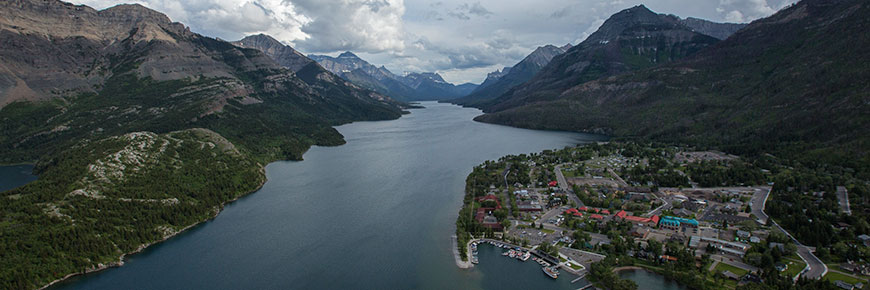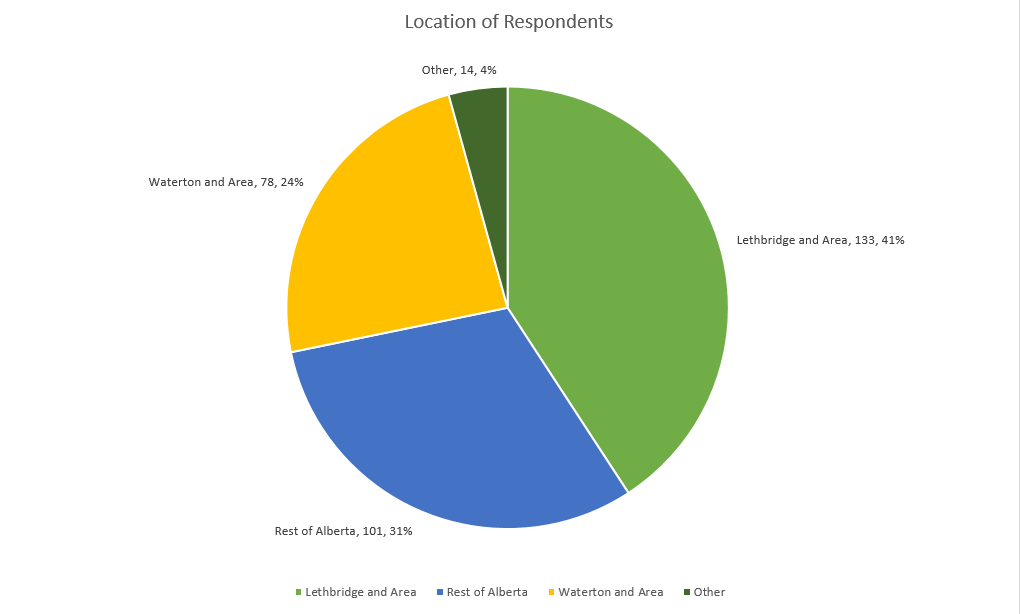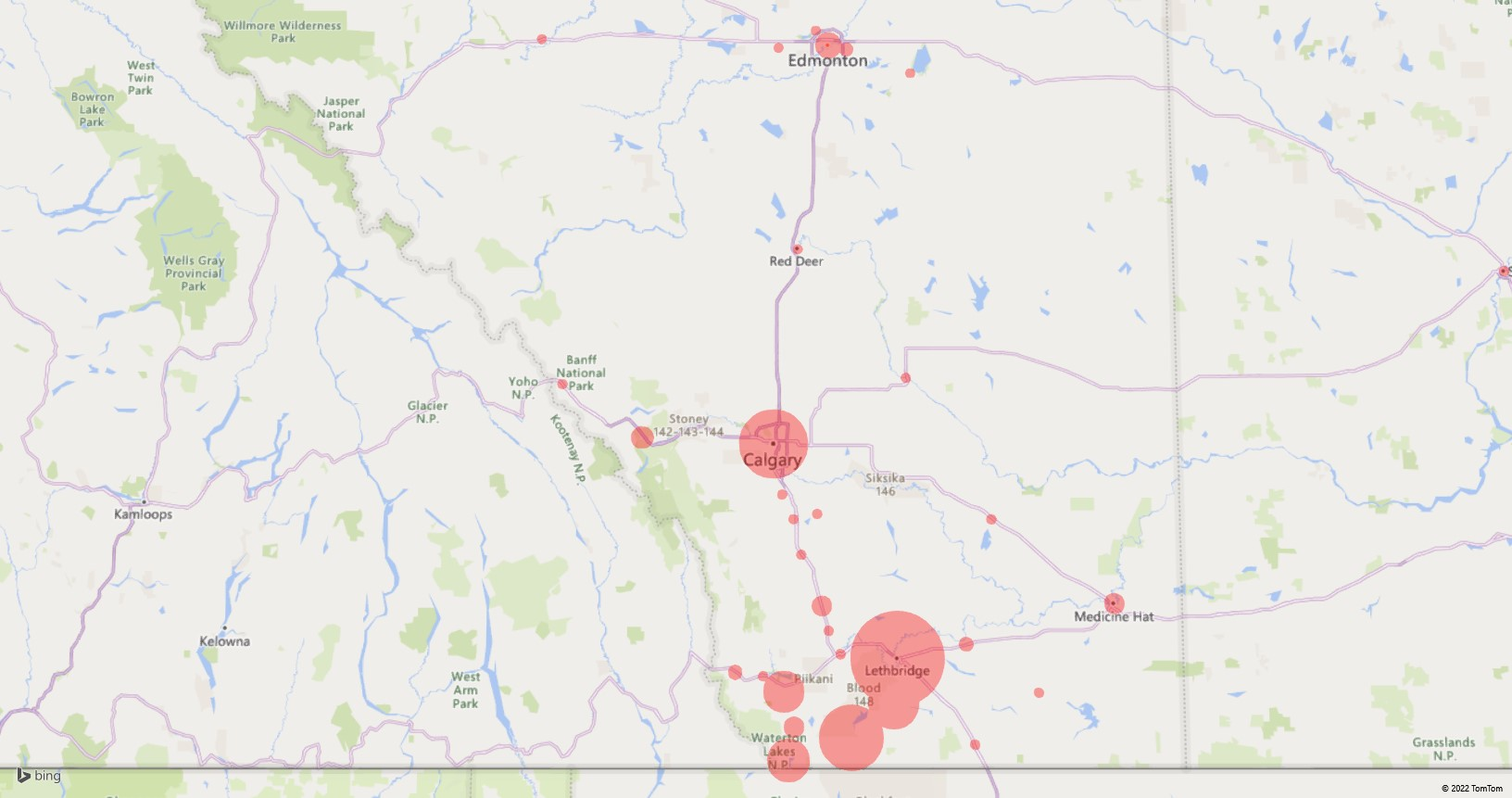
What we heard - Phase 2: Summary of Indigenous and public comments on the draft Management Plan
Waterton Lakes National Park
Waterton Lakes National Park would like to thank all those who participated and who encouraged participation by promoting the online platform within their respective networks and newsletters. The breadth of comments demonstrate that people care passionately about Waterton Lakes National Park and wish to ensure that this special place continues to be protected for future generations.Acknowledgement
The engagement process
Parks Canada is committed to providing engagement and consultation opportunities to Canadians throughout the management planning process. This report summarizes engagement activities and feedback. Meaningful opportunities were provided for Indigenous peoples, stakeholders, youth and the public to contribute to the Waterton Lakes National Park Management Plan 2022.
Engagement occurred in two phases: first on the long-term vision of the park and priorities to address over the next decade, and second to ensure the draft management plan reflected the input of Canadians. During Phase 1, input was gathered during an in-person meeting from the Glacier National Park (U.S.) management team as special partners through the Waterton-Glacier International Peace Park designation. The plan will be tabled in Parliament. The management plan provides strategic direction on priorities for the next ten years.
The second phase of engagement took place through in-person and online engagement sessions and online feedback tools between April 14 and July 7, 2021. Stakeholder engagement continued throughout summer and fall 2021 and we always welcome comments from our Indigenous partners.
Summary of phase 2 engagement activities
Waterton Lakes National Park reached out to Indigenous peoples, youth in surrounding communities, stakeholders and other interested Canadians through a range of engagement opportunities to gather feedback on the draft management plan. Participants received the draft plan, the Phase One Engagement What We Heard Report, the State of the Park Assessment, an invitation to complete a detailed survey about the plan and the park management team hosted virtual engagement sessions for interested parties.
An online platform called Let’s Talk Mountain Parks was created with the other mountain parks, enabling interested Canadians to be part of the discussion in the first phase of engagement. This platform was used again for the second phase of engagement. Social media posts, emailed bulletins and a media pitch raised awareness of engagement opportunities.
Engagement activities consisted of written correspondence from Indigenous partners and stakeholders, virtual meetings (a public engagement session, a stakeholder engagement session, staff meetings, and a joint mountain park youth workshop) and the online engagement platform.
Who we heard from
Virtual discussions
Due to the Covid-19 pandemic, engagement was conducted online. Parks Canada promoted the engagement period through social media posts and advertisements, website content, news media stories, newsletter content and meeting invitations.
Over 115 people attended five digital engagement events or interacted with Parks Canada team members to provide input on the draft management plan.
Participants in the stakeholder workshop included representatives from regional and provincial governments, environmental and philanthropic organizations, outdoor recreation interest groups, local community representatives, destination marketing organizations and local business operators.
Online comments
Parks Canada’s social media posts and advertisements promoted the engagement opportunities to over 71,000 people. The Waterton Lakes National Park Let’s Talk Mountain Parks website received 4,860 page views from 2,252 people over the three-month engagement period. Of that, 2,171 people viewed various sections of the website or downloaded background planning documents, such the State of the Park Assessment report, or took part in the survey or vision board.
Over 340 people participated in either the survey or ideas board. A total of 328 people completed an online survey and 20 people contributed ideas to the vision board. The demographic profiles were:
- 15% of respondents were 18-34 years old; 63% were 35-64 years old; 22% were over 64 years old;
- 96% had visited Waterton Lakes National Park in the last two years;
- 65% identified as a regional resident, 49% as an interested member of the public, 11% as “Other” with many describing themselves as leaseholders in the park or nearby residents, and 8% as members of tourism, hospitality and NGOs.
- Most of the respondents were from Alberta, and the majority of those were from southwestern Alberta.

Figure 1. Geographical distribution of survey respondents
Location of Respondents
Lethbridge and Area, 133, 41%
Waterton and Area, 78, 24%
Rest of Alberta, 101, 31%
Other, 14, 4%
As illustrated by the map below, the pink highlighted areas indicate that a large proportion of online respondents were from southern Alberta.

What we heard
Indigenous peoples
Parks Canada strives to work with all Indigenous peoples in as equitable of a manner as possible. Parks Canada strives to work collaboratively with all Indigenous peoples who assert the park is part of their traditionally used lands and waters, such as the signatories of Treaty 7 (Káínai, Piikáni, Siksiká, Stoney-Nakoda Nation Bearspaw, Chiniki and Wesley bands, Tsuut’ina) as well as Ktunaxa Nation and the Métis Nation. Waterton Lakes National Park remains committed to continued engagement with Indigenous partners to ensure history, culture and values are shared respectfully.
Parks Canada shared engagement opportunities and provided the draft management plan to Indigenous partners in phase 2. Indigenous partners were invited to indicate their preferred approach to engagement in the management planning process, their vision for the long-term future of the park and their recommended priorities. Parks Canada presented the draft plan to the Kainai First Nation, and the plan was discussed during a meeting with the Piikani First Nation.
Parks Canada notified Indigenous partners that formal engagement on the draft plan was concluding in January 2022 and requested any further input. Waterton Lakes National Park will maintain an open dialogue with interested Indigenous partners as the management plan is implemented to ensure it remains relevant and meaningful.
The vision and key strategies of the management plan reflect what has been heard to date during Phase 1 and 2 of engagement and ongoing conversations with Indigenous partners. It is important to note that Parks Canada continues to meet regularly with Indigenous partners on advisory roles, conservation, cultural resources, fire management and visitor experience. All of these conversations, in addition to feedback from the first phase of engagement, have influenced the development of the management plan and will continue.
The Vision for the future of Waterton Lakes National Park identifies and recognizes the longstanding role of the Siksikaitsitapi (Blackfoot Confederacy) as stewards of this area of their ancestral homelands. It envisions a future where greetings and place names in the Blackfoot language in the park remind us all of the enduring cultural, physical, and spiritual significance of Waterton Lakes. Ongoing and meaningful involvement with Indigenous partners is founded on strong relationships of mutual respect and trust. Indigenous perspectives continue to influence key decisions about the park’s future.
Parks Canada heard from Indigenous partners that Paahtómahksikimi – Waterton Lakes National Park - is a sacred place based on the Siksikaitsitapi (Blackfoot Confederacy) worldview and traditional value system, where nature and humans are deeply interconnected. This sacred kinship with the land and all of its inhabitants is based on respect and reciprocity. Recognizing significant Blackfoot heritage and the effects of colonialism promotes understanding and appreciation for this special place.
Stakeholders and the general public
Overall, Canadians indicated support for the vision and key strategies of the draft Waterton Lakes National Park Management Plan via the Let’s Talk Mountain Parks website.
Vision
Canadians were asked to rate if they agreed with the proposed vision in the draft management plan. Of the 328 responses, 85 completely agreed, 130 somewhat agreed, 34 were neutral, 50 somewhat disagreed, and 27 completely disagreed. In total, 66% of respondents either completely agreed or somewhat agreed with the proposed vision in the draft management plan.

Figure 2. Proportion of respondents Who agreed/disagreed with the plan’s vision
Question options
Completely Disagree - 27
Somewhat Disagree - 50
Neutral - 34
Somewhat Agree - 132
Completely Agree - 85
Respondents were provided with the option to provide written feedback on the draft management plan’s proposed vision. Parks Canada received 200 written responses and 128 people skipped this option. Of these responses, the majority pertained to Visitor Use Management, with how visitors access the park being a key topic. Other common responses on the vision included recommendations to make the statement clearer, to include stronger references to the park history, and to include stronger references to climate change and the protection of ecological integrity and biodiversity as the top priority. Comments on the how to present the townsite (small town, rural, rustic, charm, local,) and opinions on development were also provided.
Key Strategies
Respondents were asked how important each key strategy was to them on a scale of Very Important, Important, Neutral, Not Important, and Not at all Important. This question was mandatory. The survey showed a varying, yet broad level of support for all the proposed key strategies.
For Key Strategy 1: Conserving Natural and Cultural Heritage for Future Generations, 81% of respondents rated the strategy as either Very Important or Important.

Figure 3. Proportion of respondents who agreed/disagreed with Key Strategy 1
Question options
Not at all Important - 2
Not Important - 17
Neutral - 44
Important - 116
Very Important - 149
For Key Strategy 2: True to Place Experiences, 67% of respondents rated the strategy as either very important or important.

Figure 4. Proportion of respondents who agreed/disagreed with Key Strategy 2
Question options
Not at all Important - 13
Not Important - 32
Neutral - 63
Important - 117
Very Important - 103
For Key Strategy 3: Strengthening Indigenous Relations, 58% of respondents rated the strategy as either Very Important or Important.

Figure 5. Proportion of respondents who agreed/disagreed with Key Strategy 3
Question options
Not at all Important - 22
Not Important - 31
Neutral - 86
Important - 101
Very Important - 88
For Key Strategy 4: Connecting with Canadians, 48% of respondents rated the strategy as either Very Important or Important and a further 28% rated the strategy as neutral.

Figure 6. Proportion of respondents Who agreed/disagreed with Key Strategy 4
Question options
Not at all Important - 27
Not Important - 52
Neutral - 93
Important - 101
Very Important - 55
For Key Strategy 5: Managing Development, 69% of respondents rated the strategy as either Very Important or Important.

Figure 7. Proportion of respondents Who agreed/disagreed with Key Strategy 5
Question options
Not at all Important - 13
Not Important - 24
Neutral - 65
Important - 101
Very Important - 125
For Key Strategy 6: Regional Connectivity and Landscapes, 63% of respondents rated the strategy as either Very Important or Important.

Figure 8. Proportion of respondents Who agreed/disagreed with Key Strategy 6
Question options
Not at all Important - 12
Not Important - 17
Neutral - 93
Important - 115
Very Important - 91
The Phase 2 online survey also provided participants three open ended questions for participants to provide their feedback on the vision and six key strategies. Comments received broadly supported the key strategies. The key themes captured in these comments were protecting ecological integrity beyond borders, addressing increasing visitation while maintaining access to the park, and visitor stewardship and education. Below are the key ideas expressed based on the six key strategies.
What we heard
Conserving natural and cultural heritage for future generations
Key ideas expressed on this subject include:
- The spread of invasive species must be more effectively addressed through a trans-boundary approach. Parks Canada should actively work outside the park on connectivity and increased protection of adjacent areas in Alberta, British Columbia and Montana;
- Waterton Lakes National Park should be a place to learn about the interconnectedness of nature and culture through Blackfoot knowledge and worldviews;
- Human disturbances affecting wildlife and habitat should be reduced through education and promoting responsible behaviour.
True-to-place experiences
Key ideas expressed on this subject include:
- Some respondents felt that some visitors use the park without respect for its resources, wildlife, character or fellow park users and recommended more public education of appropriate behaviour and stronger enforcement of rules by Parks Canada law enforcement;
- Respondents would like more opportunities to experience local Indigenous culture through programs developed in close collaboration with Indigenous partners;
- Visitors should have the opportunity to hear stories about natural and cultural history of Waterton Lakes National Park through a variety of interactive approaches.
Strengthening Indigenous relations
Key ideas expressed on this subject include:
- Waterton Lakes National Park should increase collaboration opportunities with Indigenous peoples to protect ecological and cultural resources;
- Indigenous peoples should be better represented in all aspects of the park, including the public and private workforce, educational programming, management of the park and in art and culture.
Connecting with Canadians
Key ideas expressed on this subject include:
- Manage visitor expectations by clearly communicating available activities and ensuring information is easily accessible online and in the park;
- Parks Canada should conduct regular, meaningful consultation and two-way knowledge-sharing opportunities with park users, stakeholders and local communities.
Managing development
Key ideas expressed on this subject include:
- Visitation levels in certain areas of the park are very high; this can diminish visitor experience quality. There should be a visitor use management plan to address high visitation and its impacts on ecological integrity and visitor experience;
- To fulfill its mandate for public use and enjoyment, affordability of the total park experience must be considered when considering alternative modes of transportation in the park;
- Maintaining access to Waterton Lakes National Park is important when developing a visitor use management strategy.
Regional connectivity and landscapes
Key ideas expressed on this subject include:
- Parks Canada should work together with regional stakeholders such as neighbouring land managers, stakeholders and Indigenous communities when developing conservation and species-at-risk recovery initiatives;
- Waterton Lakes National Park should work with regional tourism partners to share information, data and research to strengthen regional conservation and sustainable tourism initiatives.
How the management plan evolved from draft to final
- Executive summary developed;
- Edited for grammar, syntax and Canadian Style;
- Pronunciation of Paahtómahksikimi updated to BUCK-toe-MOCK-sick-ih-mee based on Indigenous partners’ input;
- Description of some stakeholder groups revised based on input;
- Some figures, such as total infrastructure investment, revised based on updated information;
- Strengthened references to managing and adapting to the impacts of climate change in multiple areas of the plan, based on stakeholder feedback;
- Content on working with Indigenous peoples strengthened in intro to Key Strategies section;
- Revisions to objectives and targets to make them more specific, measurable, action-oriented, realistic or timely, where possible. For example:
- Tree planting target date changed from 2029 to 2030 to align with collaborativeactivities with other mountain national parks;
- Targets on developing a Visitor Use Management Strategy and a motor boating review revised to reflect public participation in those processes.
- Additional revisions included in the Management Area and Zoning sections.
Other areas of interest
Parks Canada received many comments on current operations including opening/closing of facilities, trails, washrooms, location of the new visitor centre and motorized boating access. These comments fall outside the scope of long-range management planning. The operational comments have been compiled to share with Parks Canada staff in Waterton Lakes National Park.
- Date modified :